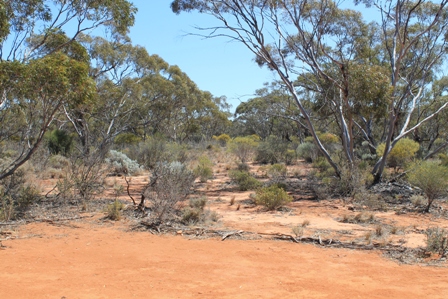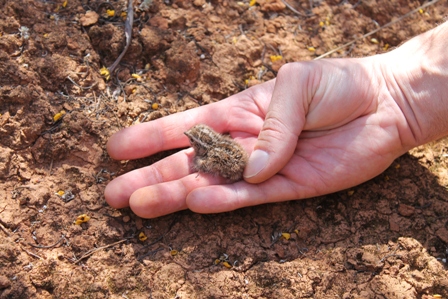
Mallee at Gluepot (Dominic Couzens)
9th October 2012
Gluepot is a fleshpot of extremely rare birds. The names “Scarlet-chested Parrot” and “Striated Grasswren” send shivers down the spines of birding geeks, and I have to confess to great excitement at the prospect of this visit. The area, named after its capacity to become muddy and impassable after the infrequent rains (10 inches a year), is at the heart of south-east Australia’s mallee zone. Mallee is a vegetation type made up from multi-trunked trees of modest height with, rather curiously, almost no ground vegetation except for spinifex, of which more later. There isn’t much mallee left in the world these days, which means that a number of mallee species are rare and restricted.
Part of the reason for my excitement at mallee-bashing at Gluepot is that we had the benefit of the guiding services of “Mr Gluepot” himself, Peter Waanders. Having worked in the area for more than 10 years, he must know pretty much every bush by now (although he kept a GPS with him at all times, since it is easy to get lost here), and his results speak for themselves. As it turned out, his birding style was distinctive in itself. He would listen, detect a bird at some range, and then move off towards the singer at similar rate to a greyhound out of a trap. None of our press pack was in poor condition, but several timers throughout the day we arrived at a bird gasping for breath (us, not the bird).
Still, Peter gets results. Within a couple of hours we had located a dishy species known as a Chestnut Quailthrush, a singing Red-lored Whistler and even a fly-over Scarlet-chested Parrot. Also, by making an excursion into the spinifex grass – which grows in thick clumps and could be fairly described as razor-sharp straw (my trainers bore the brunt) – we managed to unearth a pair of Striated Grasswrens. How the grasswrens move around the spinifex without shredding all their feathers is a mystery to me, but they hopped between spikes as if very much at home.
For me, the greatest excitement at Gluepot was to meet up with an endangered species that I had heard a lot about. The Black-eared Miner is not a thrilling species to look at (similar to Noisy Miner, below) but could almost be described as Australia’s representative of the Ruddy/White-headed Duck conundrum. The Black-eared Miner was once isolated within the mallee zone, but since its habitat and adjacent areas have been modified slightly by people, a very closely related species, the Yellow-throated Miner, has been drawn into the Black-eared Miner’s range. As a result, Yellow-throated and Black-eared Miners have begun hybridising, leading to genetic swamping of the latter. There are now only about 3700 pure-bred Black-eared Miners in existence, all of them in this area, and there are many hybrids. Miners breed co-operatively, and it is now almost inevitable that groups will consist of a mixture of pure-bred birds and hybrids. One day there may be no more true Black-eared Miners left.
As you might expect, today the Black-eared Miners were no match for Peter Waanders’s birding skills, and we soon came across a flock. It took a while to separate the pure birds (dark rump, black below eye) from the pale-rumped hybrids, and that, let’s face it, encapsulates this bird’s problem.
I left Gluepot thrilled in a solumn sort of way. However, the reserve had a final delight for us as we came across a male Painted Buttonquail and his chicks on the road out. One chick was a little less savvy than the rest…

Painted Buttonquail chick, Gluepot reserve, SA, Oct 2012 (Dominic Couzens)

Nice article, but it left me wanting much more. Could have been 4 times this length, for keen birders. Thank you very much!